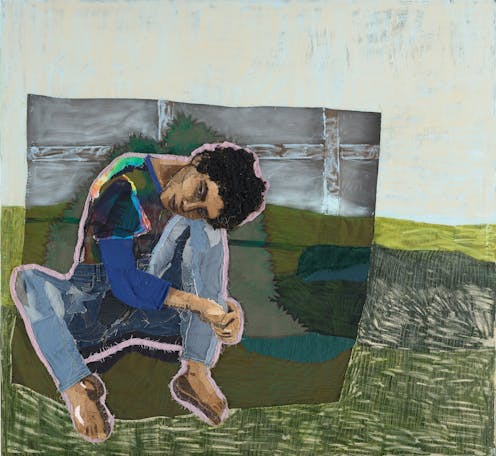As Julia Gutman’s maverick collage wins the Archibald prize, the award is truly in the hands of a new generation
- Written by Joanna Mendelssohn, Honorary (Senior Fellow) School of Culture and Communication University of Melbourne. Editor in Chief, Design and Art of Australia Online, The University of Melbourne

Julia Gutman’s Archibald-winning portrait of the singer Montaigne and Zaachariaha Fielding’s winning entry, Inma, in the Wynne Prize have more in common than their youth – although it is worth noting they both represent a new generation of artists, a changing of the guard at the Art Gallery of NSW’s annual series of art prizes.
These works – with Montaigne as the sitter and Fielding as the painter – capture the culture of music and performance that is at the cutting edge of their generation.
Montaigne, the performing name of singer Jessica Cerro, is a longtime friend of Gutman. Both share an intellectual rigour and a highly personalised approach to their art.
It is fair to say that, until recently, Gutman’s portrait would probably not have been hung, let alone won, the Archibald Prize.
For most of the last century or so, entries were dominated by portraits accurately described as “pale, male and stale”.
The change from men in suits to women in jeans, from academic portraits in oils to a maverick collage, can be charted in the Australian Cultural Data Engine’s handy Archibald Prize database, which shows the many changes over the years, from the nature of the sitters, the age and genders of the winners, increases of the prize money and even the palette used by the artists.
As J. F. Archibald’s will stipulated that the judges must be Trustees of the Art Gallery of NSW, it also shows the impact of particular trustees on deciding the winners.
When the President of Trustees David Gonski announced this year’s winners, he made a point of noting that particular consideration had been given to the views of the two artist trustees, Tony Albert and Caroline Rothwell. However, as the voting was unanimous, the trustees as a whole have endorsed this expansion of definitions of what a painting may be.
Self-contained and vulnerable
The portrait of Montaigne, Head in the sky, feet on the ground, consciously quotes Egon Schiele’s Seated Woman with Bent Knees, a deliberately awkward, edgy composition by the Austrian artist.
The pose shows the artist as both self-contained and vulnerable, hugging one knee to her body, her feet bare and open.
Gutman works in a combination of collage and paint, using materials either found or donated, roughly stitching the pieces of cloth together, happily revealing in the process. The modulated tones of the feet come from a combination of hessian and patches of gold cloth; a rainbow stripe helps define her top, a sleeve comes from the apron Gutman wore while teaching art to small children.
There is a delightful ambiguity in the landscape in which Montaigne is seated. The collage moves into paint, but the paint has been scratched so from a distance it looks as though it, too, is collage.
The painted trickery does not end here. Behind the figure a stitched in translucent panel reveals the struts supporting the painting’s stretcher: simultaneously revealing and concealing.
Including actual paint is a wise move as the Archibald has a history of discontented artists rushing off to the Supreme Court to contest the trustees decisions.
Painting the music
I first heard Montaigne’s distinctive soprano voice at a performance at the Black Dwarf theatre in 2020, just after it was announced she would represent Australia at the Eurovision song contest, only days before the world locked down for COVID – and Eurovision was postponed for a year.
The same world-changing event took Zaachariaha Fielding away from performing music in the duo Electric Fields, to making art in his home country of Mimili in the APY lands in remote South Australia.
Inma, which was awarded the Wynne Prize, is a visual celebration of the music he feels in the song and dance of this place of his childhood. Its limited palette emphasises the linear patterns and the music-like rhythm on the painted surface.
In his acceptance speech, which began with an attempt to have the waiting media throng respond to his song, Fielding paid tribute to the community arts workers of Mimili. He then led them in the song that is described in his gloriously complex and rhythmic painting.
Yet his was not the most surprising speech at the Archibald, Wynne and Sulman Prize announcements.
That honour goes to Doris Bush Nungarrayi, the senior Luritja artist who was awarded the Sulman Prize for her painting Mamunya ngalyananyi (Monster coming) – a painting showing Mamu, the shapeshifting malevolent spirits that haunt the Anangu.
Her acceptance speech, all in language, was a passionate celebration of her victory, but also a recollection of her mother’s country and the deprivations that she and her people have suffered.
As a new generation wins the Archibald and Wynne Prizes, tradition is reinterpreted in the Sulman.
Authors: Joanna Mendelssohn, Honorary (Senior Fellow) School of Culture and Communication University of Melbourne. Editor in Chief, Design and Art of Australia Online, The University of Melbourne





